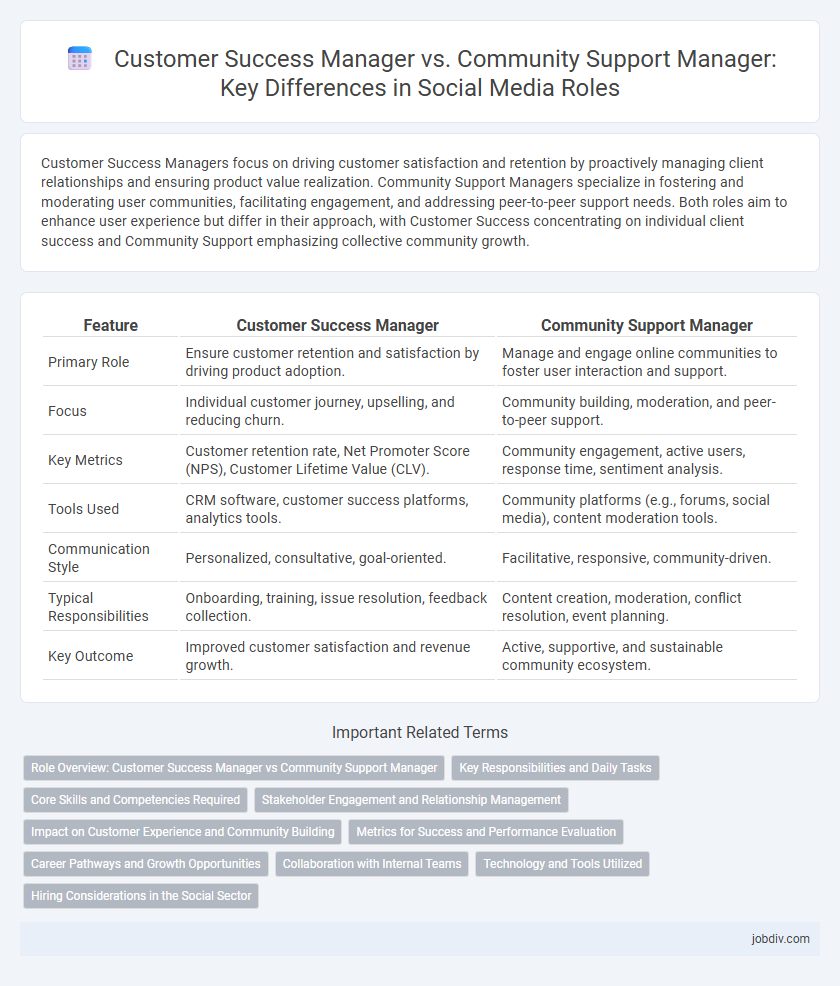Customer Success Managers focus on driving customer satisfaction and retention by proactively managing client relationships and ensuring product value realization. Community Support Managers specialize in fostering and moderating user communities, facilitating engagement, and addressing peer-to-peer support needs. Both roles aim to enhance user experience but differ in their approach, with Customer Success concentrating on individual client success and Community Support emphasizing collective community growth.
Table of Comparison
| Feature | Customer Success Manager | Community Support Manager |
|---|---|---|
| Primary Role | Ensure customer retention and satisfaction by driving product adoption. | Manage and engage online communities to foster user interaction and support. |
| Focus | Individual customer journey, upselling, and reducing churn. | Community building, moderation, and peer-to-peer support. |
| Key Metrics | Customer retention rate, Net Promoter Score (NPS), Customer Lifetime Value (CLV). | Community engagement, active users, response time, sentiment analysis. |
| Tools Used | CRM software, customer success platforms, analytics tools. | Community platforms (e.g., forums, social media), content moderation tools. |
| Communication Style | Personalized, consultative, goal-oriented. | Facilitative, responsive, community-driven. |
| Typical Responsibilities | Onboarding, training, issue resolution, feedback collection. | Content creation, moderation, conflict resolution, event planning. |
| Key Outcome | Improved customer satisfaction and revenue growth. | Active, supportive, and sustainable community ecosystem. |
Role Overview: Customer Success Manager vs Community Support Manager
A Customer Success Manager focuses on building long-term relationships with clients by ensuring they achieve their desired outcomes using a product or service, driving retention and growth. A Community Support Manager concentrates on fostering and moderating user communities, facilitating engagement, and providing timely support to enhance user experience. Both roles aim to improve customer satisfaction but differ in their primary focus on individual client success versus community-wide support and interaction.
Key Responsibilities and Daily Tasks
Customer Success Managers focus on ensuring client satisfaction through onboarding, product training, and proactive issue resolution, driving retention and revenue growth. Community Support Managers oversee user engagement by moderating forums, facilitating peer interactions, and managing content to foster a supportive online environment. Both roles require strong communication skills but emphasize different aspects of customer relationship management and community building.
Core Skills and Competencies Required
Customer Success Managers excel in client relationship management, data analysis, and strategic planning to drive customer retention and satisfaction. Community Support Managers demonstrate strong communication skills, conflict resolution, and community engagement expertise to foster active, supportive user communities. Both roles require empathy, problem-solving abilities, and proficiency in CRM and community management tools to effectively support and grow their respective audiences.
Stakeholder Engagement and Relationship Management
Customer Success Managers excel in proactive stakeholder engagement through personalized onboarding and continuous value delivery, driving long-term client retention and satisfaction. Community Support Managers focus on fostering open communication channels and building trust within user communities, enhancing brand loyalty and peer-to-peer support. Both roles prioritize relationship management but differ in targeting individual customers versus broader community ecosystems.
Impact on Customer Experience and Community Building
Customer Success Managers drive personalized customer journeys that increase retention and satisfaction through proactive support and strategic account management. Community Support Managers cultivate vibrant user communities, fostering peer-to-peer engagement and collective problem-solving that enhance brand loyalty and advocacy. Both roles synergize to create a seamless customer experience and a robust, engaged community ecosystem.
Metrics for Success and Performance Evaluation
Customer Success Managers prioritize metrics like customer retention rates, Net Promoter Score (NPS), and expansion revenue to evaluate performance, focusing on driving long-term client loyalty and growth. Community Support Managers measure success through engagement rates, response times, resolution rates, and community sentiment analysis to ensure active participation and effective issue resolution. Both roles rely on customer feedback, but Customer Success emphasizes revenue impact while Community Support centers on fostering a vibrant, responsive community.
Career Pathways and Growth Opportunities
Customer Success Managers drive client retention and expansion by ensuring product adoption and satisfaction, often progressing into roles like Head of Customer Success or VP of Customer Experience. Community Support Managers build engaged user communities, fostering brand loyalty and often advancing toward Director of Community or Social Engagement roles. Both career pathways emphasize relationship-building skills but differ in focus: Customer Success leans toward strategic account management, while Community Support centers on grassroots engagement and advocacy.
Collaboration with Internal Teams
Customer Success Managers collaborate closely with sales, product, and marketing teams to ensure customer satisfaction and drive retention through tailored solutions and proactive support. Community Support Managers work alongside social media, content, and moderation teams to foster engagement, resolve community issues, and build a thriving online environment. Both roles require seamless communication and alignment with internal departments to enhance overall customer experience and brand loyalty.
Technology and Tools Utilized
Customer Success Managers leverage CRM platforms such as Salesforce and Gainsight to track customer health scores and automate personalized communications, optimizing retention and growth metrics. Community Support Managers utilize forum software like Discourse and social media management tools such as Hootsuite to foster engagement and monitor sentiment across digital communities. Both roles integrate analytics platforms, including Tableau and Google Analytics, to drive data-informed decision-making and enhance user experience.
Hiring Considerations in the Social Sector
Hiring a Customer Success Manager in the social sector requires candidates with strong relationship-building skills and experience in client retention strategies to drive long-term engagement and impact. In contrast, a Community Support Manager should demonstrate expertise in conflict resolution, community outreach, and social listening to foster active participation and trust among diverse groups. Prioritizing cultural competence and empathy is essential for both roles to effectively address the unique challenges of social sector stakeholders.
Customer Success Manager vs Community Support Manager Infographic

 jobdiv.com
jobdiv.com